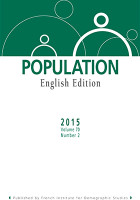
Population 2015, n°2
2015
The Masculinization of Births. Overview and Current Knowledge
Christophe Z. Guilmoto
- AIDS and Religious Life in Malawi: Rethinking How Population Dynamics Shape Culture
Jenny Trinitapoli
- Gender Relations and Contraceptive Practices of Palestinian Couples
Sarah Memmi, Annabel Desgrées du Loû
The Development of Fertility Theories: A Multidisciplinary Endeavour
Henri Leridon
The Masculinization of Births. Overview and Current Knowledge
Christophe Z. Guilmoto
The masculinization of births is a recent phenomenon resulting from prenatal sex selection. This paper reviews recent research on imbalances in the sex ratio at birth and the corresponding mechanisms, determinants and future implications. The mechanisms affecting the sex ratio at birth are reviewed, with an emphasis on factors relating to sex discrimination. The figures available provide an overall picture of skewed sex ratios since the 1980s in Asian and Eastern European countries. Large differences in the male surplus are also observed across birth orders, region and social group, owing above all to the conjunction of three phenomena: a preference for male children inherited from socio-familial systems, the emergence of assisted reproductive technology enabling prenatal sex selection, and a decrease in fertility that heightens the risk of not having a son. Recent research has analysed the demographic consequences of the masculinization of births on the future composition of the population and explored how social systems may adjust to these imbalances, with political responses to prenatal discrimination still proving relatively ineffective. The paper also reviews some of the main future research avenues.
AIDS and Religious Life in Malawi: Rethinking How Population Dynamics Shape Culture
Jenny Trinitapoli
This study examines the reciprocal nature of the relationship between religion and demographic processes in the context of Malawi’s AIDS epidemic between 2001 and 2006. Based on unique data from religious leaders and lay women in rural Malawi, this article shows that religious teachings have been responsive to the demographic realities of AIDS. Predictably, this involves the explicit incorporation of AIDS-related information into teachings on sexual behavior and family formation. More surprisingly, however, Christian and Muslim teachings about marriage and divorce address one of the fundamental problems associated with AIDS: balancing the prevention strategy of leaving a spouse who is putting you at risk of infection with marital, social, and religious obligations to care for the sick. A doctrine of acceptable divorce, “the window of opportunity” reflects an effort to coalesce the sometimes incompatible goals of protecting individuals from HIV, limiting the spread of the disease in the community, maintaining social cohesion, and expanding religious authority. This examination of religious doctrine in the face of a particular demographic crisis illustrates how and why local understandings of demographic phenomena can have profound cultural implications.
Gender Relations and Contraceptive Practices of Palestinian Couples
Sarah Memmi, Annabel Desgrées du Loû
Through the prism of gender relations within the couple, this article analyses how married couples manage birth control in the Palestinian Territories, where fertility remains high despite women’s high level of education. Using data from the Palestinian Family Health Survey conducted in 2006 and from detailed interviews of married men and women conducted in 2010-2011, we analyse the prevalence of contraceptive use in the Palestinian Territories and its determinants, as well as the influence of each spouse in contraceptive choices according to their type of conjugal relationship, and the link between gender relations within the couple and the type of contraception used. Although contraceptive use is widespread, it remains subordinate to the powerful social norm of having many children, especially sons, which prevails irrespective of the woman’s
socio-demographic characteristics. The organization of fertility control varies according to the type of conjugal relationship, and depends on individual reproductive histories. Contraception and reproduction nevertheless always involve both spouses, and the couple is emerging as the main decision-making unit.
The Development of Fertility Theories: A Multidisciplinary Endeavour
Henri Leridon
This article retraces the history of fertility theories as illustrated by 23 founding texts grouped together in a single volume (Leridon, 2014, Les théories de la fécondité, INED). Until recent times, no reliable statistics were available for the analysis of fertility behaviours, which were treated rather as a question of philosophy, morals, political science or religion. It was not until the birth of the social sciences in the nineteenth century that the first real theories of fertility started to emerge. At that time, the demographic transition in Europe and the accompanying social and economic transformations gave rise to new demographic behaviours for which a theoretical framework was needed. Many new disciplines were brought into play, including anthropology, sociology, economics, political science and psychology. Paradoxically, demographers were slow to develop theoretical approaches, doubtless because the discipline first made its name as a quantitative science. Indeed, no overarching, generally acknowledged theory of fertility has yet been developed. These different approaches are illustrated through a series of pioneering texts. They present theories drawn from a wide range of disciplines and include analyses from the perspectives of birth control and gender.
Prix TTC : 20,00 €

